




























































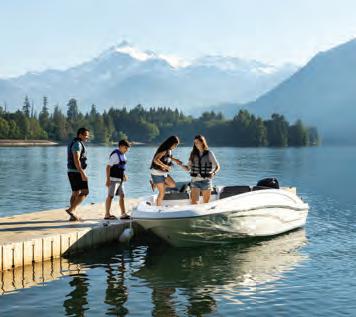
Embarking on the open water is an exhilarating experience, flled with the promise of adventure and relaxation. Whether you’re a seasoned sailor or a weekend cruiser, protecting your vessel with proper insurance is not just a choice—it’s a necessity. Explore the reasons why every boat owner should prioritize boat insurance for a worry-free voyage.


The open water can be unpredictable, with unexpected storms, collisions, or other potential accidents. Boat insurance can give you fnancial protection if there is damage to your vessel, providing coverage for repairs or replacement.
Accidents on the water can result in damage to other boats, docks, or even injuries to passengers. Boat insurance offers liability coverage, which can pay for damages or injuries you’re liable for while boating, up to specifed limits, and lawsuit costs if you’re sued. This includes damage you cause to another watercraft or if someone on or near your boat is injured and you’re found to be legally responsible.
Unfortunately, boat theft and vandalism are realities that boat owners face. Boat insurance has comprehensive and collision coverage that can protect you against events outside of your control, including theft and vandalism.
Accidents on the water may lead to injuries for you or your passengers. Boat insurance offers a range of optional medical payments coverage limits, helping to cover medical expenses if you are in an accident or someone is hurt on your boat, regardless of fault.
If you fnanced the purchase of your boat, most lenders require insurance coverage to protect their investment. Having boat insurance not only fulflls these requirements but also gives you peace of mind knowing that your fnancial interests are safeguarded.
Some water municipalities and marinas may require proof of insurance for docking or accessing certain areas. Boat insurance allows you the fexibility to explore different destinations without worrying about entry restrictions.
Emergency towing and assistance
Progressive boat insurance can include optional Sign & Glide® On-Water Towing coverage. If your boat is disabled or breaks down on the water, Sign & Glide® pays for on-water towing, jump starts, soft un-groundings, and fuel delivery.
Wreckage removal
If your boat sinks, Progressive boat insurance will cover the cost of removing your boat from the water (if removal is legally required).
Investing in boat insurance is not just about protecting a valuable asset; it’s about safeguarding the memories, experiences, and joy that come with your on-water adventures. Don’t let unforeseen circumstances disrupt your journey—navigate with confdence, knowing that Progressive boat insurance has you covered. Ensure a smooth and worry-free voyage, because when it comes to your boat, peace of mind is the ultimate luxury.
Scan to get a quote in as little as 4 minutes
learn more.


























The quest to find the ultimate men’s watch has traditionally been a difficult one in the world of fashion. A timepiece with the perfect look and functionality has long been the goal of both watch designers and enthusiasts alike.
The Renegade Blue Chronograph Men’s Watch is the perfect combination of style and function. With a sleek design that features a bold blue dial, rose gold hands and hour markers, and a durable sports silicone band, this timepiece will instantly elevate any outfit.
The three sub-dials provide a precise timekeeping function. The sports silicone band is durable yet comfortable, providing a secure fit that won’t slide around on your wrist. The band is also easy to clean and maintain, making it perfect for everyday wear. The watch’s 30 Metre Water Resistance rating ensures that it has you covered whatever the occasion.
The Renegade Blue is also built to last, with a sturdy stainless steel caseback and exquisitely detailed bezel. The watch is powered by a super reliable quartz movement, which is covered by our incredible 5 Year Movement Warranty - ensuring accurate timekeeping for many years to come!
At the amazingly low price of just $99 plus S&H, this watch is an absolute steal. Don’t miss out on the chance to own the Renegade Blue and Rose Gold Chronograph Men’s Watch - order yours today!





By Dr. Benjamin Cole


Tarpon (Megalops atlanticus), known as “silver kings,” are renowned for their acrobatic leaps and strength, making them a top target for anglers. However, their fascinating migration patterns also play a crucial role in maintaining marine ecosystems.
Tarpon migration is largely driven by the need for feeding and reproduction. Tese highly
migratory fsh can travel thousands of miles, infuenced by water temperature, food availability, and spawning needs. Preferring temperatures above 72°F (22°C), tarpon move south during colder months, seeking warmer waters.
the U.S. Atlantic coast, they travel from Virginia to Florida and the Caribbean, while in the Gulf, they move from Texas and Louisiana to Mexico. Teir northward migration begins in late spring, driven by rising temperatures and abundant food. By summer, tarpon reach as far as Virginia, signaling the start of fshing season. As fall sets in, they return south to warmer wintering grounds.
A key driver of tarpon migration is spawning, typically occurring between May and September in ofshore areas with strong currents. Afer spawning, larvae are carried into estuarine environments like mangroves and marshes, crucial nurseries for juvenile tarpon. Tese habitats are essential for the species’ survival, but environmental degradation threatens their health.
While tarpon are primarily a catch-andrelease species, improper handling during fshing can lead to mortality. Conservation eforts, including safe fshing practices and habitat protection, are essential for sustaining tarpon populations. Organizations like the Bonefsh & Tarpon Trust work to monitor migration, protect critical habitats, and promote responsible fshing.

Found in the Atlantic Ocean and Gulf of Mexico, tarpon migration varies by region. Along
Tarpon migration is a remarkable journey, driven by the search for favorable conditions. By protecting these iconic fsh and their habitats, we can ensure their survival and preserve their role in marine ecosystems for future generations.

Capt. Russ Walker

If a fsh can see the bait, they’ll hit it much faster than if they must search through grass or mud. Tat’s why I rig to suspend the bait, keeping it above the bottom where fsh can easily spot it. Grass fats are incredibly productive fshing grounds, and targeting the edges where the fat drops of into deeper water is the key to catching bigger fsh.
In around fve to six feet of water, grass growth stops, forming a natural erosional edge where fsh like trout, cobia, tarpon, and mackerel hunt. Tese edges act like a “superhighway” for predatory fsh. While smaller fsh are found on the fat, the big ones hang near the edge, diving into the deeper channel when necessary.
Te best tool for this fshing method is a fat-topped popping cork. Te cork keeps the bait suspended at the desired depth and makes a popping sound when tugged, drawing fsh to the noise. Tis is especially useful for beginners, as it’s an easy technique that produces great results. With just a few pops, the live shrimp below the cork will jump into plain sight, attracting the fsh.
As a charter captain, I’ve found this method efective for anglers of all experience levels. It’s not uncommon to catch 80 to 100 fsh during a four-hour trip using this rig. It works equally well ofshore near wrecks, suspending bait for species like permit.
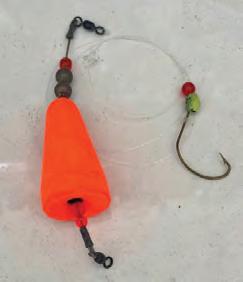
I make my own 200 lb. rated, fat-topped popping bobbers, stronger and shorter than store-bought versions. Tey’re perfect for fshing

everything from trout to tarpon, with only the hook size and leader changing. Te leader length is always four and one half feet, and the magic depth on the grass-fat edge is fve feet.
Typically, I use a 3/0 Mustad Wide Gap Hook with a 1/4 oz. egg sinker and a 30 lb. fuorocarbon leader. Tis rig works wonders for trout, pompano, mackerel, snook, redfsh, and ladyfsh.
So, give it a try! Pop the cork a few times, remove the slack, and hang on. When the bobber disappears, just “yank it and crank it.” You’ll see your catch increase by at least 40 percent. Fish On!
Capt. Russ Walker is a USCG Masters licensed fshing guide and owner of Tide Walker Charters out of Cape Coral, FL. www.tidewalkercharters.com
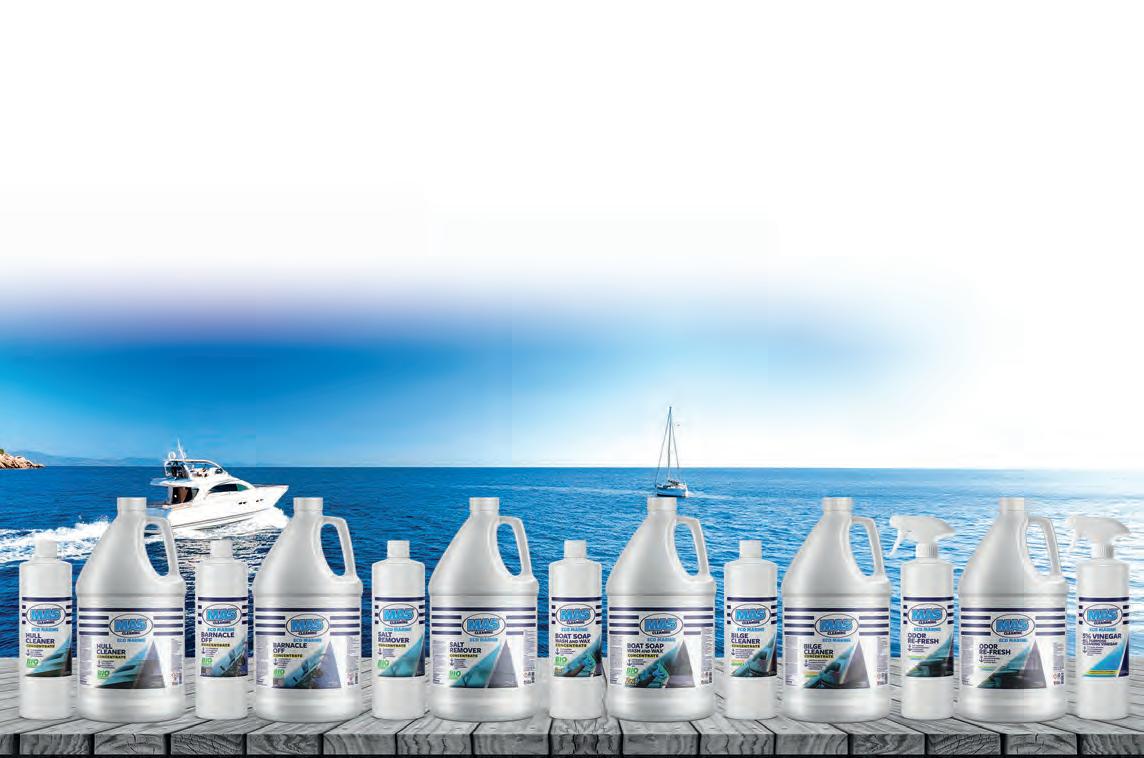

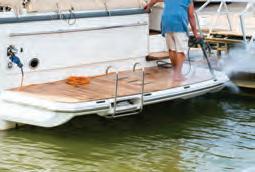


By Jeff Durniak | Unicoi Outfitters www.ncwildlife.org/fishing/trout-fishing-north-carolina
Many southeastern trouters eagerly await the fall kickoff of Delayed Harvest (DH) trout fishing programs in our states. Trout are stocked about monthly from fall through spring and catch-andrelease regulations help us enjoy high catch rates during this special season.
While the wildlife agencies do a fine job of spreading out that first batch of stockers, the fish are often bunched up at the start until higher flows scatter them out. I consider that first month “famine and feast fishing” for many anglers. Here are a few tips for y’all.
First, go hunting. Knot on a #8 black or olive woolly bugger and cover some water. Make a few casts, strip that bugger through some pretty water, and hope for a strike. If none in three casts, move on! You’re hunting for that sweet spot of the agency fish drop.
Next, camp out. After your first fish, hang out at that pool and work it well. When the hits quit on your original bugger color, change colors to entice a few more takers. And when the bugger bite ceases, change to a dry/dropper or indicator-nymph rig for more hookups.
Repeat this process as needed as you wade along the creek. Hunting for honey holes is a great way to put flyfishing rookies on fish and hook them on the sport, as success breeds avidity. Good luck scoring high on DH streams this fall!
NOTE: Hurricane Helene did a number on North Carolina streams and Wildlife Commission trout hatcheries. Their first DH stockings were postponed at the time of this writing. Check the NCWRC trout page for updates before you head north.
















Contributed By: Chris Scalley River Through Atlanta Guide Service
The days are getting shorter, and the cooler evenings are the trigger for brown trout activity on the Chattahoochee River. Where we normally catch 10 to 1 rainbows to browns all of spring through summer this abruptly flip flops in the Fall season through the early Winter. Because brown trout are Fall spawners their behavior gets more aggressive and maybe these fish sense the impending Winter so peak feeding windows go from nocturnal to even daylight hours. Whether you’re nymphing, using a dry fly or streamer, the browns just seem to come out of the woodwork during the abundance of Autumn!





Forecast by: Capt. Clay Cunningham www.catchingnotfishing.com | 770-630-2673
The Fall bite is here on Lake Lanier. The lake looks good despite the rain from the hurricane. The water is also clearer than you would expect with the rising lake level and the stripers have been schooling on top at random times. Look for these schools to be very large in size. You may see them from several hundred yards away. All types of topwater bait will work, but each day, a different one will be the key choice. Two key baits are the Berkley Magic Swimmer and the Berkley Driftwalker. So far this Fall, the Magic Swimmer has been on fire. We have been catching them on the new colors of the Magic Swimmer for several weeks now. Two great new colors are perfect ghost and olive bone. The 110 and 125 size are the two key sizes. Spool up a Penn Battle III 4000 spinning reel with 12-pound Trilene Big Game line on a 7-foot medium heavy Fenwick spinning rod
and you are good to go. If the water is calm, pick up the Berkley Driftwalker. This bait will zig zag across the surface. If you have any wind, throw the Magic Swimmer. The south end of the lake will most likely continue to be the key area, but the stripes may quickly be found further north on the lake. Some are already being caught on the north end.
If you want to use live bait, pull some freelines, which are simply baits with no weight, 100 feet behind the boat tipped with a blueback herring. All you need is a Shakespeare Striper Rod paired with a Penn Fathom II Linecounter reel spoiled with 15-pound Trilene Big Game line, and a 1/0 Gamakatsu Octopus hook. The herring will do the rest. Pull the herring across humps and points and you will catch stripers and spotted bass. See you on the water


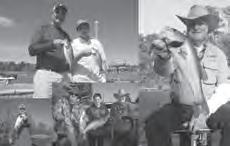




Lake Lanier is 38,000 acres of prime fishing and home to some of the best spotted bass and striped bass in the world. There are dozens of hotels within minutes of the lake, professional fishing guides to increase your odds of catching the “big ones” and plenty of action in Gainesville, Georgia to keep the family entertained! Check us out at ExploreGainesville.org to find out more.

By Capt. Cefus McRae | Nuts & Bolts Fishing Series Hartwell, GA
Weather systems come in all shapes and sizes. From the gentle spring rain to torrential summer squalls, to extreme events like the recent hurricane that devastated a large portion of the southeast US.
Rain events help replenish the oxygen in our reservoirs, farm ponds, river systems and even the ocean. They also wash silt and ground debris into these waterways, sometimes making getting around in a boat downright dangerous. Large, water-logged timber can float just inches under the surface. Difficult to see from a running boat, especially if your helm is lower, like in bass boats. Hit a large log at speed and you can flip the boat, throughout passengers, or knock the lower unit off your boat.
Typically, rain tends to muddy up the water as well; turning relatively clear lakes into something that resembles chocolate milk. And all that particulate in the water makes life uncomfortable for finned crit-

ters. They will matriculate to areas with ‘cleaner’ water, if possible, and that’s the place for us anglers to be.
On the day after a significant rain, you can see these zones at creek mouths that flow into the main river channel. There will be a distinctive color change, from muddy water to clearer water. Often, there’s a scum line that helps to distinguish it as well. Look at your Simrad as you cross from dirty water to clean water and notice the amount of ‘noise’ on the screen. That’s the particulate in the water. And you’ll also notice bait and predator fish right on the edge. It could be just inside the muddy water, or just outside. I’ve


found the big fish like to hang out just inside the dingy water and use it as cover to ambush bait fish. Drag your trolled lures or cast your swim baits just outside the dingy part, and if that doesn’t work, try moving to the inside edge. I’ve caught some really big fish this way. And those floating logs and floating ‘islands’ of debris also serve as temporary

cover for fish as well. Just like fishing weeds or lily pads. So, give them a shot as well.
Sometimes when we are given lemons, we just need to make lemonade. Fish the trash, and you might find a gem or two.
Forecast By:Will Harkins- Getfishingguide.com | Williamharkins11@gmail.com


November has arrived. And so has the cooler weather. Old man Winter isn’t too far away! This is also the time of year the holiday parties and calories start to add up. (On a real note, they really need to align turkey season and Thanksgiving. Only makes sense.) As such, it can be hard to find time to get on the water. But November is hands down my favorite time to be on Nottely. The weather is perfect, the leaves are still beautiful, and the traffic is very low. Cooler water temps mean the bass are gorging on bait for the winter. On any given day, it could be your best day of the year in terms of quality or numbers. Largemouth are still creeping around up shallow, waiting on a bluegill-colored square bill or Z-man chatterbait. Pitching a jig or worm around the remaining laydowns and docks are surefire ways to catch some fish as well. The spotted bass are still roaming

around looking for bait. This time of year, they get on brush piles really good as well. Small swimbaits, jerk baits, and a drop shot will provide a steady stream of bites. As always, get out there and Get Fishing! Time to pack on the holiday food for the winter!
#Godsgotthis
Lake Nottely: Lake Level: 6 ft below full. Temp: 65 degrees Clarity: Clear


































Looking back at photos for the past four years most of my trips in November were excellent.
Jigging a 7/8 War Eagle spoon in white with a bit of red on the front is awesome. Look for humps near deeper water that are around 25 feet deep. Tap the bottom of the boat with a rubber tipped broom handle or similar stick for about 5 minutes. Drop the spoon to the bottom (you will see your line go slack). Reel in the slack with your rod tip pointed down. Then lift the rod tip about three to four feet and lower it back down until it makes contact the bottom. Keep very little slack in the line by lowering it just slow enough to do so. The bite will often happen on the drop.
Trolling bass minnows slowly behind the boat will work as well. This produced for Chad and his son “Bear” pictured here!
Forecast for November Crappie – I looked back at my report from 2021 (Pre LiveScope for most of us) and trolling was the thing. Put out a spread of rods with 6/lb HiVis Mr. Crappie line. I use Litewire Hooks jigs in 1/16th and 1/32nd often rigged double with a Jiffy Jig. My favorite color is June Bug. I troll at 9/10th mph.

Fly Fishing – There is usually an afternoon bite especially when Georgia Power is generating. Look for the gulls dive bombing shad on long points. Cast a chartreus and white clouser tied on a #2 hook. I use a 9-foot, 8 weight rod with intermediate line and just a 5-foot piece of 12 lb fluorocarbon leader. The retrieve is 5 short strips followed by a stop to let the fly drop and repeat. Use a strip set with your rod at the 10 o’clock position and fight the fish on the butt of the rod.
Final Words Contact me at wmoore1700@outlook.com or call 404-317-9556 to book your trip. Fall and winter fishing is great here! Tight Lines, and God Bless.


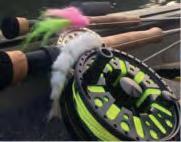
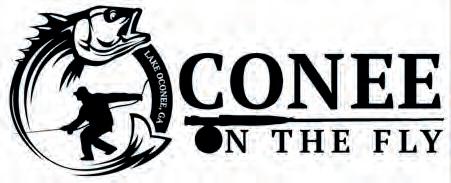
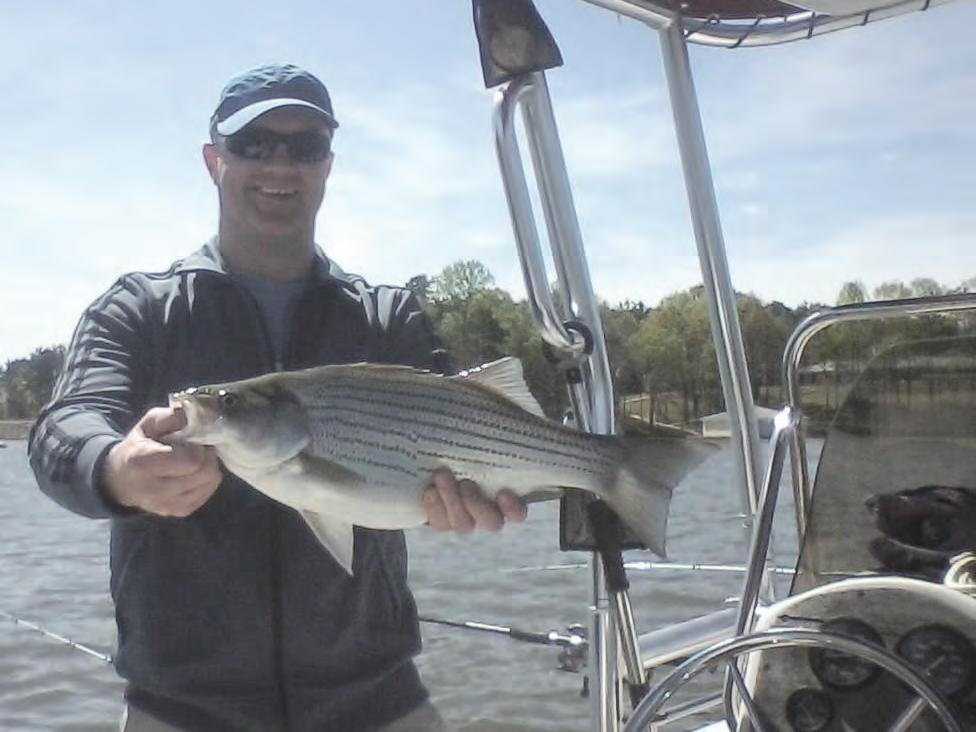












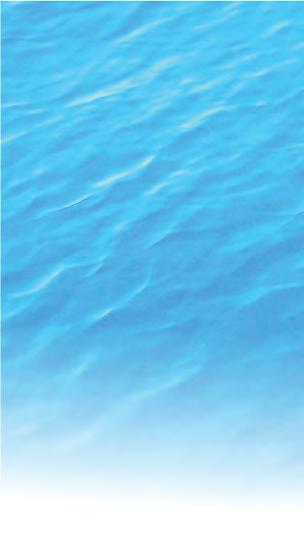


















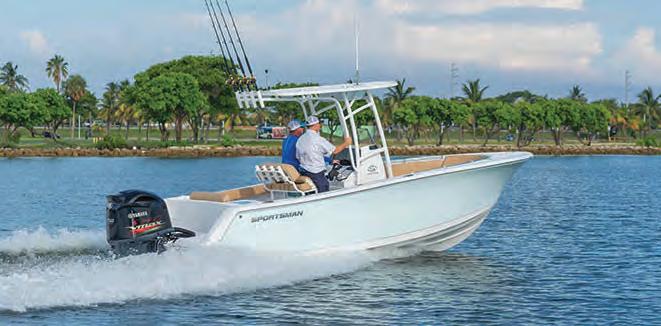







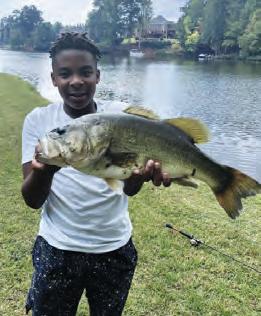
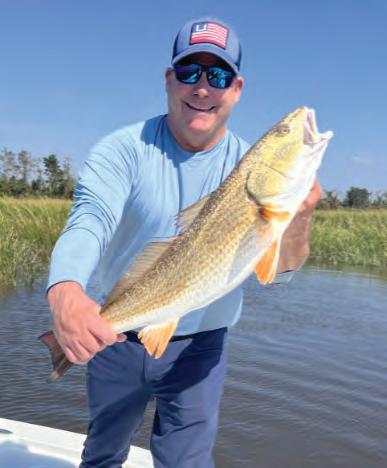
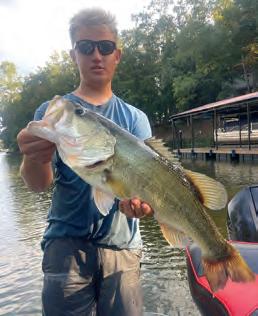




TRACY PATTERSON
Costa Rica is a renowned destination for anglers, ofering calm seas, ideal fshing conditions, and worldclass fshing. It is especially popular among female anglers due to its safety, tournaments, and supportive crews, making it an unforgettable experience.
If you’re seeking high odds of catching billfsh, Costa Rica is the place to be. On a full day ofshore, it’s common to get multiple strikes. Te fat, calm seas make it enjoyable for anglers of all levels, letting you focus on reeling in catches rather than battling rough waters.
Costa Rica hosts two ultra prestigious women-only tournaments: the Ladies Angler Tournament at Los Suenos Resort and Marina, and the Pescadora Billfsh Championship at Marina Pez Vela. Both tournaments create a supportive

yet competitive environment for anglers of all skill levels. Te Pescadora Championship is
particularly unique, ofering two Female Angler of the Year awards based on diferent fshing techniques. It encourages women to challenge themselves and grow in the sport.
Costa Rica is ranked #1 in Central America for safety, and recent laws further protect women from harassment. Female anglers can feel comfortable walking around resorts and marinas. Charter feets also adhere to strict safety regulations, ensuring peace of mind while on the water.

Whether you’re staying at a boutique hotel or a private home, Costa Rica ofers a range of accommodations for groups of all sizes. Many resorts are conveniently located near marinas, allowing easy access to fshing trips and other adventures.
Costa Rica is home to many women who support the lady angler movement. Te captains and crews are eager to teach beginners, helping them hook their frst billfsh or refne their skills. With women accounting for a growing percentage of anglers, Costa Rica ofers a welcoming and empowering environment for female anglers.
Whether you’re an experienced angler or a frst-timer, Costa Rica ofers an unbeatable fshing experience. Its exceptional conditions, tournaments, safety, and camaraderie make it the top destination for lady anglers.






IBy Capt. Michael Okruhlik
t’s that thrilling time of the year, founder time! Te fall migration, reaching its peak in November along the Gulf Coast, promises an exciting infux of founder to their spawning grounds. Louisiana, following Texas, has also implemented a closed season during this peak run. But remember, the inability to keep fatties during this time doesn’t dampen the thrill of catching them.
Flounder will be migrating into the Gulf during this time, so the apparent ambush areas will be around passes that lead to the Gulf. Te founder will position themselves in diferent regions based on the tide level and current strength. In addition to using their burying-in-the-sand ambush technique, they also utilize structure in several ways.
First, any object that protrudes above the bottom is a great ambush point. Tis ofers a current break for forage fsh to gather directly above a buried founder, making for an easy meal. Objects such as bulkheads are also great ambush points. Flounder like to position themselves against the solid barrier and I think this can be for two separate reasons depending on what other factors are at play. As mentioned above, it could be a current break, especially if the bulkhead has a corrugated shape. When a founder settles against a bulkhead, its prey has less direction in which it can fee, allowing the founder greater odds of capturing it. When targeting founder, never pass up a bulkhead.
Secondly, founder can be caught using a variety of lures and live bait, especially if you keep it in contact with the bottom to increase your chances of a strike. When it comes to live bait, a frisky mullet is your best bet for landing a larger founder. If you’re aiming for a trophy, this is the way to go. Personally, I prefer fshing with lures, particularly the paddle tail style. Jerk-style sof plastics and bucktails can also be efective when worked in the same manner.
If I had to pick a tide to maximize my time on the water, I would choose a medium fow outgoing. Although there are no set rules that fsh always follow, I feel the founder feed more on their way out to the gulf, utilizing

the current to ease their journey. Contrary to the incoming tide, they bury themselves rather than fght against the current.
Don’t let the closed season discourage you from targeting founder during this migration; it will have its advantages. Going forward we will undoubtedly have a larger founder population, but the instant gratifcation will be a lot less trafc in our favorite founder spot! I will use the closed season to target a new personal best this season, as should you.
Capt. Michael Okruhlik is the inventor of Knockin Tail Lures® and the owner of www.MyCoastOutdoors.com.



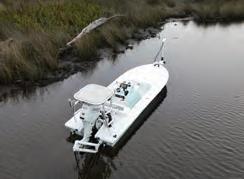







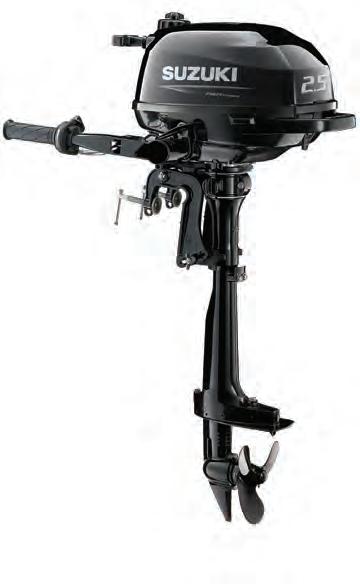

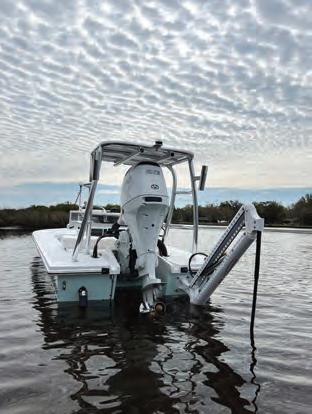

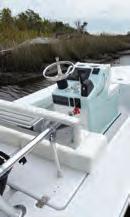


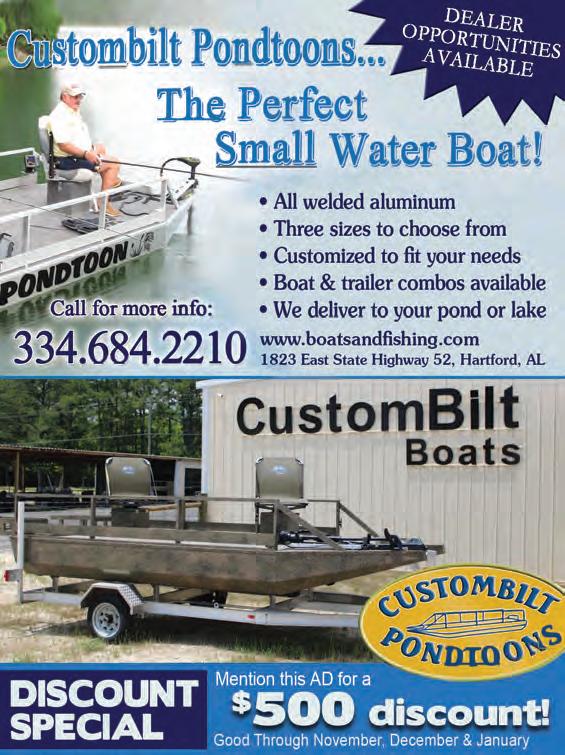

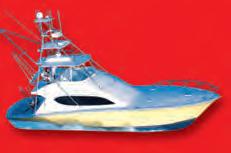


OTim Barefoot

f course, October is when it all starts, but if you like to bottom fsh, then November is the month the turbo kicks in, leading to the crescendo of the year… December. I’ve always said the week of Christmas is the apex of the grouper fshing calendar, and I’ll stand by that statement now. Tis is when larger (male) gags move inshore to establish their territory on inshore ledges, wrecks, and live bottom, much like buck deer making scrapes and rubs to mark their territory. Tese males now wait for the smaller females to show up in numbers to spawn, and the bite traditionally goes of the charts.
A small piece of hard bottom can attract large numbers of fsh if it contains the right ingredients. First and foremost, you need to locate their food. Go to the places that have traditionally held the bait—cigar minnows, sardines, beeliners, etc. “Find the bait, fnd the fsh” has been my thought process for years. Tese fsh won’t show up to a party without food—common sense. You can anchor up on a stack of bait without seeing a big mark of fsh, but afer a few bites, you’ll notice the screen light up with more and more fsh showing up.
Anchoring up is key to shallow water grouper fshing. Te sound of fsh feeding travels great distances and doesn’t go unnoticed. Once an area is fred up, constant bites supercharge the atmosphere down there. If you’re drifing, you won’t get a specifc area fred up; you’ll only go back where you got bites. But if you anchor, the fsh come to you to join in. Tis draws the alpha predators—big sharks. Yes, you’ll lose some fsh and tackle to these bruisers, but enjoy the ride while it lasts. When sharks show up, it’s time to move on to another ledge or further down the same one.

Back to noise... Keep in mind that while we hear very little, fsh hear everything. Sound travels far underwater, and everything you do on deck—slamming cooler lids, dropping hard objects, loud music, yelling—is heard by the fsh. It could be the diference between catching smaller cows or big bulls. Large male groupers didn’t get old by being dumb. You don’t kill big bucks by being noisy, so treat your fshing with the same respect.
Te folks that target grouper come home with grouper. Te ones who go “bottom fshing” with cut bait and chicken rigs come home with “bottom fsh.” As Franklin Covey said, “begin with the end in mind.” If you’re targeting grouper, think and act like it. Put baits on the bottom that avoid trash bites. Spend time jigging up some of that “trash” and drop them back down on a Decoy Jig for optimal results. Watch some of my videos on YouTube (Tim Barefoot) for examples of what I’m saying.
For more information, visit barefootcatsandtackle.com.





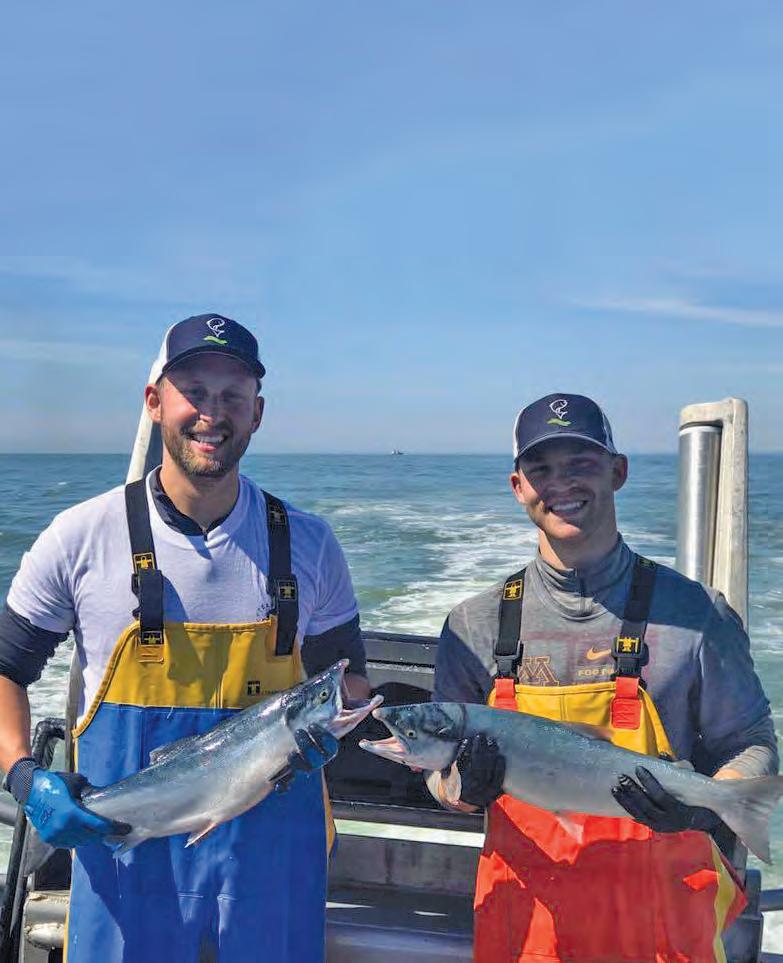



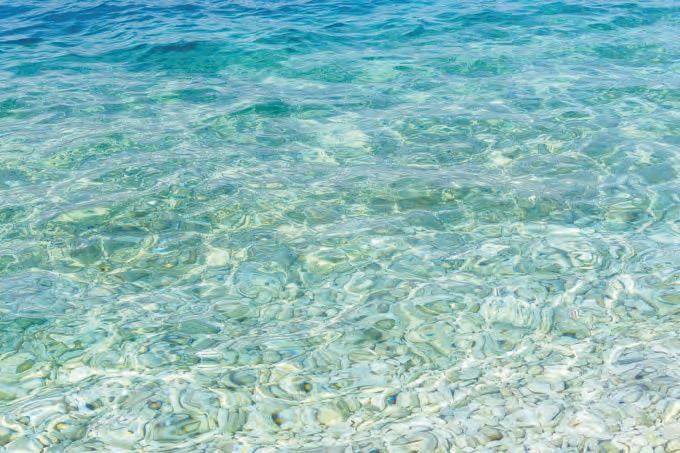






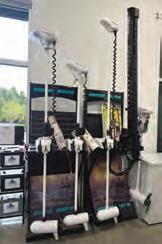




You want AI Routing! Let TZ MAPS with AI Routing make route planning a snap. Don’t take our word for it. Scan here to see for yourself how easy it is!